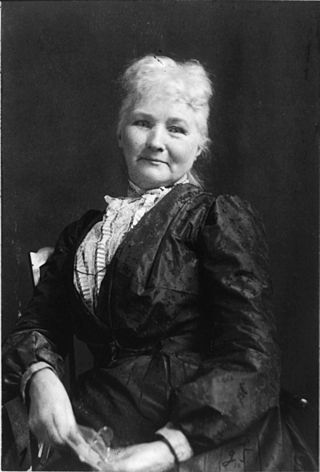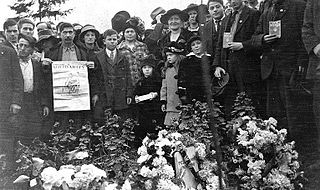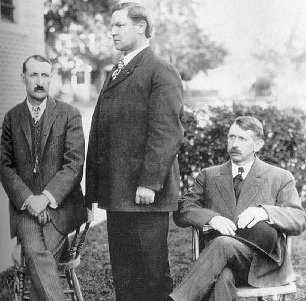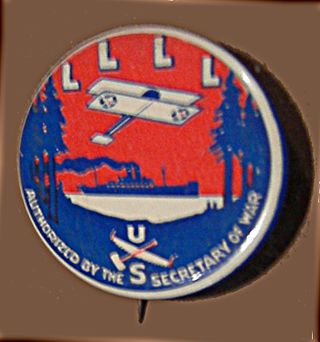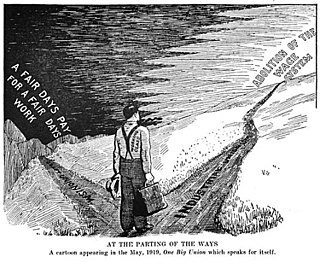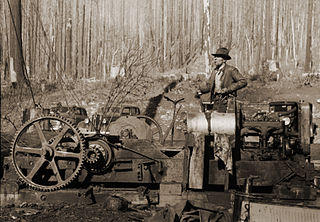Background
Miners' strike on the Mesabi Range

In mid-1916, miners on the Mesabi Range in northern Minnesota launched a spontaneous labor strike. [4] The range, situated about 75 miles (121 km) north of the city of Duluth, was a major iron ore mining region and part of the larger Iron Range. [5] [4] This strike began with a walkout led by Joe Greeni, a Czech immigrant, on June 2, and at its peak it involved several thousand miners, primarily immigrants. [6] The labor dispute lasted for several months, but by September, with strike funds running low, numerous instances of violent confrontations between strikers and law enforcement officials, and many of the strike leaders imprisoned, miners began to return to work, and the strike officially ended on September 17. [6] [1] Despite the strike ending without a labor contract in place between the miners and the mining companies on the range, many of the companies began instituting changes to address the causes of the strike, such as increased pay and an eight-hour workday. [6]
IWW presence in northern Minnesota
During the strike, union organizers from the Industrial Workers of the World (IWW) helped to organize the miners. [1] The IWW, whose members are known as Wobblies, had been established in Chicago in 1905 at a meeting of socialists and miners from the Western United States. [1] [7] The organization was a radical anti-capitalist union that advocated for industrial unionism and the concept of the One Big Union. [1] [7] Over the next decade, the union had established a presence in Minnesota, organizing a local union of lumberjacks in Deer River in 1910 and participating in free speech fights in Duluth and Minneapolis in the early 1910s. [7] However, the miners' dispute had caught the union off guard. [1] Despite this, shortly after it began, the IWW established a local union in Virginia, a city of slightly over 10,000 people on the range, [1] and helped the miners to coordinate strike actions and write a list of demands to the mining companies. [6] The local union, Metal Mine Workers' Industrial Union No. 490, was based out of the Finnish Socialist Hall, a meeting hall for socialists among Virginia's community of Finnish immigrants. [8] Many Finns in the area had been involved in the strike and were supportive of socialist ideals and the IWW in particular, and socialist halls such as the one in Virginia existed in many of the towns along the Mesabi Range, serving as centers for community life. [8] During this time, Local 490 established many branches in cities throughout the range. [7] Following the end of the strike, Local 490 remained as the largest IWW organization in northern Minnesota, with about 2,000 of the 10,000 to 15,000 miners who participated in the strike remaining members. [1] The local union was led by secretary-treasurer Charles Jacobson, a long-time native of Virginia who worked as a miner. [1]
Lumber industry in northern Minnesota

With the collapse of the miners' strike, many miners went to work in the area's lumber industry. [4] Many lumber workers in the area also worked in mining during the summer months, [4] and in late 1916, a significant number of lumberjacks had been involved in the miners' strike and were subsequently blacklisted by those companies. [8] During their early years, the IWW had focused on organizing lumber workers primarily in the Western and Southern United States, [7] and they had seen tremendous success in the Pacific Northwest, [4] but they had only minor progress in organizing the industry in Minnesota and the larger Great Lakes region. [1] However, starting in September 1916, Local 490 began to focus on organizing the 1,200 workers of the Virginia and Rainy Lake Lumber Company. [8] The company was a concern, [9] combining the Weyerhaeuser company's holdings in northern Minnesota, the Edward Hines Lumber Company's holdings in Minnesota and Wisconsin, and the Cook and O'Brien Company's processing facilities in Virginia. [8] The Virginia plant was at the time the largest producer of white pine wood in the world, [10] [4] producing an average of 1 million board feet of lumber per day. [8]
Mill workers were receptive to labor organizing due to the long hours and low pay they experienced on the job. [4] At the Virginia plant, the mill workers' schedules included 12-hour days and 7-day weeks, with an average hourly pay of between $2.50 and $3 [4] [8] (equivalent to between $67 and $81 in 2022 [11] ). These workers made on average about 25 percent less than mill workers in the Pacific Northwest, which had already largely been organized by the IWW, [8] and their hourly pay was significantly less than the average Virginia laborer's during this time. [4] In an 84-hour week, the average Virginia and Rainy Lake mill worker made about what an average Virginia laborer earned in 50 to 54 hours of work, and many worked 6 days per week. [4] While there had been several sporadic strikes and attempts at largescale labor organization among mill workers in the Great Lakes region since the late 1800s, such as efforts from the Knights of Labor, the region remained relatively unorganized and with lower pay than in other regions. [12]
Organizing efforts among lumberjacks
As an industrial union—as opposed to a craft union—the IWW sought to organize all workers in the area's lumber industry, which would include both the mill workers and the lumberjacks. [4] Lumberjacks in northern Minnesota worked in poor conditions and during their employment lived in company-owned bunkhouses on logging camps. [13] The typical bunkhouse measured 80 feet (24 m) by 30 feet (9.1 m) in area and housed between 60 and 90 men. [13] Lumberjacks shared beds in these close quarters, which were often lice-infested, and in 1914, investigators for Minnesota's Department of Labor reported that "the conditions under which the men were housed ... made it impossible for men to keep their bodies free from vermin". [13] Additionally, the houses were poorly ventilated and insulated, toilet facilities at the camps were often extremely primitive, and there were no first aid facilities despite the high injury rate among lumberjacks. [14] In 1914, two state investigators stated in a report after visiting a camp, "Both of us regretted that we did not have the authority to order all the men out of the camp and burn the place to the ground". [15] Men worked six- or seven-day weeks at the camps, [note 2] though their isolation from many nearby towns meant that they often remained at their camps even on their days off, and the typical lumber season lasted between 3 and 6 months. [15] Many earned between $35 and $40 per month [16] (equivalent to between $941 and $1,076 in 2022 [11] ). These camps had an extremely high turnover rate, with the Virginia and Rainy Lake Lumber Company employing a total of 22,000 people in lumberjack positions in 1916, but only ever having about 2,000 employed at one time. [15] The average worker left after 74 days, resulting in an entirely new crew about once every month for many camps. [15] Additionally, lumberjacks were often looked down upon by town residents and other members of society, who derogatorily called them "timber beasts". [15] Lumberjacks were drawn to the IWW as a way to improve both their working conditions and stance in society. [15] In many of the towns in northern Minnesota, lumberjacks were welcomed in IWW halls, where they could sleep, socialize, and discuss organizing plans with others. [15]
The Agricultural Workers Organization
In 1915, a new branch of the IWW was established: the Agricultural Workers Organization (AWO) No. 400. [17] The AWO focused on organizing workers in the agricultural industry in the Midwestern United States, doing so by sending "job delegates" to work alongside other workers and introduce them covertly organize them. [17] By 1916, due to a series of small-scale but effective strikes and an increase in demand for grain in Europe caused by World War I, the AWO successfully helped workers achieve higher wages, and their membership grew to about 20,000 by year's end. [17] In late 1916, the AWO (which at the time was headquartered along Hennepin Avenue in Minneapolis) sent job delegates into the lumber camps in northern Minnesota. [17] The IWW offices in Bemidji served as the AWO's local headquarters for these efforts, while other IWW offices in Duluth, Gemmell, Minneapolis, and Virginia also helped with the drive. [17] The AWO planned for the organizing effort to last through 1917, at which point they felt they would have enough support among the lumberjacks to call for a strike. [13]
Prelude to strike action
Through late 1916, IWW organizers discussed working conditions and organizing with millworkers and began to plan a strike action. [8] One of the most vocal advocates for a strike was Jack "Timber Beast" Beaton, [4] an IWW member and long-time lumberjack from Wisconsin. [8] Beaton was a popular leading member of Local 490 due to his fiery oratory and militant stance on issues regarding strike action. [8] This put him in disagreement with Jacobson and other IWW organizers, who were more cautious about the prospects of a strike. [8] [4] In December 1916, tensions between these two sides were exacerbated after five nationally known IWW organizers who had been arrested during the miners' strike on charges of murder were released as part of a deal that saw several rank and file union members charged with manslaughter. [8] Some of the more militant unionists such as Beaton viewed the deal as a sellout by the IWW, and acting without direct approval from the national union, they began to prepare for a strike. [18]

On December 24, several dozen organized millworkers met with Beaton at the Finnish Socialist Hall and drafted a list of demands to be submitted to the mill operators. [19] The demands included a flat pay increase for all workers of 25 cents per day, eight-hour shifts on Sundays and Saturdays, an end to Sunday night shifts, shift changes every week, and an end to union suppression. [4] [19] [20] The workers then elected a committee of six individuals to present these demands on December 26, with a deadline of noon on December 27. [19] Jacobson was opposed to the idea and telegraphed IWW General Secretary-Treasurer Bill Haywood, who told Jacobson, "a successful strike at the present time in the Virginia mills would be hopeless. Must wait until better organized. Continue with organization work". [19] Despite this, the meeting with mill management went as planned on December 26, [19] and Jacobson reluctantly agreed to officially sanction the possible strike action. [15] The demands were submitted to Chester R. Rogers, the manufacturing superintendent for the company, who rejected them. [19] During their meeting, Beaton also stated that, if their demands were not met, lumberjacks would also go on strike in an act of solidarity, though Rogers dismissed that possibility. [19] Shortly after the meeting, Rogers hired a large number of guards for the mill and requested St. Louis County Sheriff John R. Meining to deputize them, which he did. [21] Additionally, Sheriff Meining deputized Rogers and placed him in charge of the guards. [3]
As December 27 passed with no official response from the company by noon, the workers began to prepare for the strike. [4] That night, Beaton oversaw a meeting of about 700 workers at the Finnish Socialist Hall, where a strike resolution was passed. [19] At the same time, Beaton and Jacobson organized a "flying squad" of about a dozen men to go to the logging camps throughout the area to spread the word of the strike to the AWO job delegates and convince the lumberjacks to stop working as well. [15] The IWW organizers had worked with individuals who were familiar with the conditions on the logging camps and had created a list of demands for the lumberjacks as well, which included no discrimination against union members, a 9-hour workday, a $10 per month pay increase (equivalent to $270in 2022 [11] ), a minimum wage of $40 per month (equivalent to $1,100in 2022 [11] ), negotiable salaries, better food, and improved sleeping, toilet, and cleaning facilities. [22] [20] Three lumberjacks from each camp were to submit these demands to the camp foreman. [2] The demands from both the mill workers and the lumberjacks stipulated that both groups would remain on strike until both sets of demands were satisfied. [20]




